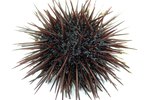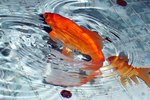
Nerite snails include several dozen species of marine snails from the Pacific, Indian and Caribbean oceans, and many brackish water species from lagoons and swamps. Also called zebra snails for their distinctive shell stripes, they're often sold as freshwater algae eaters despite the fact that most are unable to live for long and none can successfully breed in freshwater. The freshwater environment is the most likely, but not the only possible, explanation for your snails' death.
A Mean Surprise
Almost all nerite snail species live and breed in oceans; they are considered marine by zoologists, yet they regularly end up in the freshwater aquarium section of pet stores. This is because large populations live in the brackish water of intertidal zones. Brackish describes water that is a combination of salt and fresh. It's less concentrated than seawater, but still very salty compared to a freshwater aquarium. Labeling these species freshwater creatures is truly a misnomer. Since they come from brackish environments, some species and individuals are able to adapt to freshwater well enough to live up to a year -- a fraction of their natural life span. Many others don't make it even a year. Even species widely listed as freshwater on aquarist websites, such as Vittina semiconica, Niritina natalensis and Vittina coromandeliana, exist only in brackish environments in nature. One known nerite, Theodoxus danubialis, naturally lives in freshwater -- but it isn't found in the pet trade.
Need an Air Drop
Nerites are frequently sold as "clean-up crews" specifically to remove algae from tanks. They're excellent at this because clinging algae actually form the bulk of their wild diet -- something that isn't true of many other species sold as algae-eaters. Unfortunately, once they finish your algae, they'll still need to eat. If you don't provide food, such as sinking pellets and fresh vegetables, they will starve to death. Their inability to live lengthy lives or reproduce in freshwater is considered a plus by some hobbyists who want algae removal without introducing a permanent snail population to their tank.
Change of Scenery
Species from intertidal zones have an additional often-overlooked requirement -- the need to periodically switch from being submerged to resting on an exposed surface. It's not completely understood why this is physiologically necessary for some tide pool animals, but if they're deprived of one of these habitats they eventually succumb to stress and disease.
An Unintended Move
Nerite snails, like most marine animals in the pet trade, are usually wild-caught, because breeding is difficult in saltwater and impossible in freshwater. Though they lay copious numbers of eggs, few hatch; almost none of the eggs survive under typical aquarium conditions. Collection for the pet trade is extremely destructive to wild ecosystems as well as inhumane to the individual animals, which are more likely than their captive-bred fellows to carry diseases and parasites and to die of stress. Certain aquarium additives, particularly copper-based fish medications, can also kill them.
References
- FishChannel.com: Aquarium Snails -- What to Keep and What to Avoid
- FishChannel.com: Algae Problem in Your Fishtank? Find Out Which Species Really Eat Algae
- AdvancedAquarist.com: Aquarium Invertebrates - Nerites - Bleeding Tooth, Zebras, Checkers and More
- PlanetInverts.com: Zebra Nerite Snail
- BrackishFaq: Tropical Brackish Water Snails
- Neritopsine Gastropods Lifedesk: Vittina Semiconica
- IUCN Red List: Neritina Natalensis
- Neritopsine Gastropods Lifedesk: Vittina Cormandeliana
Photo Credits
-
Seiya Kawamoto/Photodisc/Getty Images
Writer Bio
Angela Libal began writing professionally in 2005. She has published several books, specializing in zoology and animal husbandry. Libal holds a degree in behavioral science: animal science from Moorpark College, a Bachelor of Arts from Sarah Lawrence College and is a graduate student in cryptozoology.




